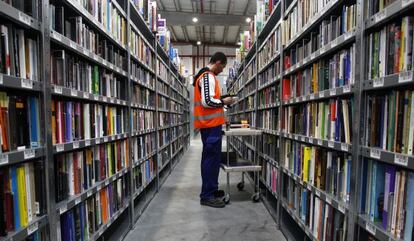What happens after the click...
Online retailer Amazon's operation in Spain is already starting to outgrow its massive warehouse space Record order numbers are expected this Christmas


It's 8.45am. The Amazon warehouse in San Fernando de Henares, in Madrid, is packed with products ahead of the Christmas season, which is the time of year when most packages are dispatched. The online retailer is expecting to see a spike in orders on December 16. On that day in 2012, there were 43,000 orders on the website in just 24 hours, but this year the company is expecting to better that figure considerably. As such, the firm will have 600 staff at the warehouse to deal with the demand, compared to the 210 on hand last year, explains the company's operations director, Fred Pattje.
The managers of the logistics center are meeting in the warehouse to check on the day's orders, which will be sent all over Spain and out to other European countries too. The team is made up of 14 people, and led by Jon, an architect who is the second-in-command on this gigantic 32,000-square-meter installation. Together they are responsible for solving the problems that arise in the warehouse, problems that are classed as "zombies" should they go unsolved for more than a week. It's an odd term, but it reflects the jargon used by the Amazon staff, which is a mixture of English vocabulary and acronyms.
“We pay all the tax we have to pay”
Francois Nuyts is the general manager of Amazon in Spain, a market in which the online retailer had great expectations, ones that have been exceeded. "We have progressed a lot faster here than in any other European country," Nuyts explains.
Customers in Spain now have access to 32 million products through the Amazon website, which is 7 million more than last year, and the idea is to continue at this pace.
After two years of activity, he explains, "we have become the top e-commerce site in Spain," adding that the company "will continue investing so that our customers enjoy the best possible products."
According to the director, the key to the success of Amazon is allowing its customers to get hold of products as quickly and cheaply as possible. "The appetite of the Spanish consumer is higher, and that's why we are investing here," explains Nuyts.
The Spanish site received 4.3 million visits last month, which represents a rise of 132 percent compared with the same period last year.
The Spanish subsidiary of Amazon declared accounting losses of 54,329 euros in 2012, according to the data it must send to the Spanish Register of Companies. The company invoices from Luxembourg in order to pay less tax, a practice that has raised a few eyebrows among the general public.
"In Spain we pay all of the taxes we have to pay," he explains. "Listed companies have a responsibility to minimize our tax burden. If the law needs to be changed, well then it should be changed."
In 2012, a total of 800 problems were solved on the site, in a process of continuous improvement. The issues they deal with can include anything from a software fault in the new system that records images of the products, or the machine that is used to wrap CDs (they fixed the latter problem by reducing the speed at which the process was running).
After that meeting is over, the visit to the Amazon logistic center is taken over by Fred Pattje. It starts in the loading bay, where 30 trucks packed with goods arrive each day. During the busy Christmas season, that number rises to 40. Spain has its own unique characteristics, given that the public buys gifts not just for Christmas, but also for Kings' Day, or Reyes, on January 6. This means there are two spikes in activity during the holiday season. Demand goes up by 400 percent during the month of December, Pattje explains.
From here, the items are sorted into two types: large or small. There is no measurement in between. Each product is then submitted to a quality-control process that lasts six seconds, to determine whether or not it is in the right condition to be sent to the customer, and whether it has any faults, such as scratches or marks on a book cover, for example. They are then registered, weighed, measured and even photographed, to be later wrapped in plastic or to be stored in the warehouse, which is already becoming too small for the company's needs, and will be extended vertically as needed, explains Pattje.
The 25 logistic centers that Amazon counts on in Europe store at least 10 of the 32 million products that the platform sells. When the orders are received, processes are set in motion at the San Fernando de Henares site. The express deliveries — which are purchased and received in one day — take just three hours to be processed, explains the head of the warehouse. This is achieved thanks to the combination of human and information technology that is designed down to the very last detail.
Take, for example, the GPS scanner that is used to find the products that make up an order among the four floors of the enormous site, which in 2012 saw 19,000 products sent out every day. The warehouse worker is given a route to take so that the time taken to collect all the different products from the order takes the shortest time possible. Jesús says he will probably put together more than 800 orders today. From his trolley, the items are then taken to the grouping area, and then to the packaging section, where the mechanized and computerized system tells the employee which box to choose from the dozen or so at their disposal. The invoice for the order is placed in the bottom of the box, as customers prefer to see their items before the sale document. Rosa has packaged up 246 items today.
A conveyor belt then takes the packages to the loading bay, and they are directed to their corresponding truck. "The system knows the capacity of each truck," explains Pattje in the warehouse, which is packed with the most popular gifts this Christmas, which include the new Kindle and the PlayStation 4.
There have been some more surprising demands this year, however. Thanks to the popular Spanish TV drama El tiempo entre costuras, which follows a young dressmaker during the Franco era, the sale of sewing machines has risen 135 percent.
Tu suscripción se está usando en otro dispositivo
¿Quieres añadir otro usuario a tu suscripción?
Si continúas leyendo en este dispositivo, no se podrá leer en el otro.
FlechaTu suscripción se está usando en otro dispositivo y solo puedes acceder a EL PAÍS desde un dispositivo a la vez.
Si quieres compartir tu cuenta, cambia tu suscripción a la modalidad Premium, así podrás añadir otro usuario. Cada uno accederá con su propia cuenta de email, lo que os permitirá personalizar vuestra experiencia en EL PAÍS.
¿Tienes una suscripción de empresa? Accede aquí para contratar más cuentas.
En el caso de no saber quién está usando tu cuenta, te recomendamos cambiar tu contraseña aquí.
Si decides continuar compartiendo tu cuenta, este mensaje se mostrará en tu dispositivo y en el de la otra persona que está usando tu cuenta de forma indefinida, afectando a tu experiencia de lectura. Puedes consultar aquí los términos y condiciones de la suscripción digital.
Últimas noticias
Maduro pleads not guilty before the federal court in New York: ‘I am still the president of Venezuela’
A new test can detect Alzheimer’s from a finger prick
UN team enters Sudanese city of El Fasher after paramilitary massacre: ‘It’s like a ghost town’
A recipe for resistance: Indigenous peoples politicize their struggles from the kitchen
Most viewed
- Gilles Lipovetsky: ‘If you want to live better and fall in love, take Prozac, don’t look to philosophy’
- Alain Aspect, Nobel laureate in physics: ‘Einstein was so smart that he would have had to recognize quantum entanglement’
- Alvin Hellerstein, a 92-year-old judge appointed by Bill Clinton, to preside over Maduro’s trial in New York
- Maduro’s downfall puts China’s relationship with Venezuela to the test
- Why oil has been at the center of Venezuela-US conflicts for decades








































